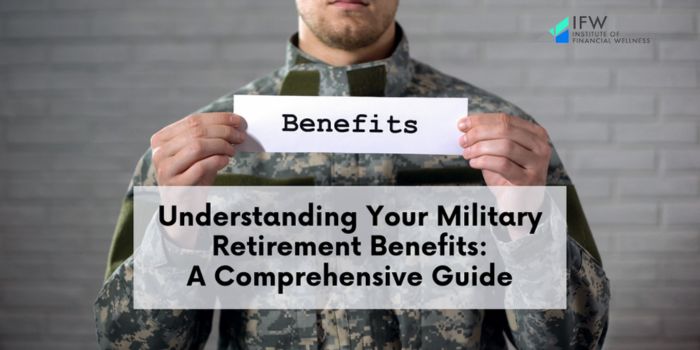“Retirement life is different because it is more relaxing and calm. You get to choose what to do every day.” — Julie Hebert
What exactly are military retirement benefits, and how will they affect your future? If you’ve served in the armed forces, navigating your well-earned retirement perks is the key to a financially secure post-service life. Brace yourself! It’s time to steer you through the Blended Retirement System, precisely how your benefits are calculated, and what other entitlements you might expect. Dive into the details that matter most as you prepare for your next chapter beyond the uniform!
Discover how to achieve wealth unlimited in your retirement with The IFW’s Retirement Roadmap services. Get started today for a secure financial future!
Key Takeaways
- The Blended Retirement System (BRS) combines a pension with a savings plan and includes provisions like the Thrift Savings Plan (TSP), which allows service members to contribute to their retirement with matching contributions from the Department of Defense.
- Military retirement benefits calculation varies by the date and criteria, such as the Final Pay or High-36 plan, and includes considerations for disability retirements and Career Status Bonuses under the REDUX Retirement Plan.
- Other military retiree benefits cover healthcare, such as TRICARE, education, and employment assistance through the GI Bill and VA services, housing support with HUD-VASH and VA loans, and the foreclosure pause on VA-backed home loans through May 31, 2024.
May: A Month of Remembrance and Gratitude for Military Service


May is a month of great importance for individuals in military service, their families, and veterans because it has been officially recognized as Military Appreciation Month. This time is set aside to pay tribute to the men and women who have served or are currently serving in our armed forces, marked by significant anniversaries and occasions related to the military.
This month includes events such as the celebration of Victory in Europe Day (VE Day), marking the conclusion of World War II on that continent, and extends recognition towards children whose parents have made the ultimate sacrifice while serving. During May, we are encouraged to take a moment to contemplate and express gratitude for those who commit themselves to duty within our uniformed services.
Understanding the Blended Retirement System

The transition from military service to civilian existence is complex, and grasping the Blended Retirement System (BRS) is vital in this process. As a retirement program within the military, the BRS merges a traditional pension scheme with an investment component aimed at fostering savings for retirement and offering advantages to those who serve.
Those entering into military service post-January 2018 are enrolled by default in the BRS. Individuals already serving prior to this date were presented with a choice: either opt-in for this new system or continue under their existing legacy retirement plan.
Basic Pay and Retirement Contributions
The primary compensation for individuals serving in the military is their basic pay, which fluctuates depending on one’s rank and length of service, among other considerations. Within the framework of the Blended Retirement System, it’s this basic pay that serves as a basis for calculating both individual and military contributions toward retirement benefits. Consequently, your earnings not only reflect current financial remuneration, but also influence future investment into your retirement.
Indeed, there is a powerful motivation to strive for advancement in rank—each step up can have a substantial effect on your long-term savings through enhanced retirement payouts from higher basic pay scales.
Defined Benefit vs. Defined Contribution
There are primarily two types of retirement plans to understand: defined benefit and defined contribution plans. The former assures a specific income after retiring, funded and managed by the employer. Conversely, with a defined contribution plan, it is up to the employee’s contributions combined with any matching from their employer that shapes eventual retirement funds.
Within the Blended Retirement System (BRS), service members have access to the Thrift Savings Plan, which functions as a defined contribution plan. This allows individuals in service to allocate part of their pay into this savings vehicle for future financial security upon retirement.
Thrift Savings Plan and Matching Contributions

The TSP stands as a key component of the BRS, particularly for individuals who enlisted in the service after January 2018. This plan includes automatic contributions from the Department of Defense that become fully vested after two years of dedicated service.
For those serving, one notable benefit is that their personal contributions to the Thrift Savings Plan are matched by the Department of Defense up until they reach their 26th year in service. Such matching contributions can greatly enhance retirement savings accumulation, offering substantial financial security for later life.
Retirement Pay Calculation Methods
Delving into the specifics of the Blended Retirement System (BRS), we shall now explore how retirement pay is determined, which can greatly affect your ultimate pension amount. There are two key calculation methods adopted by the military: one based on Final Pay and another known as High-36 [1].
Under the Final Pay method, each year of service contributes 2.5% toward your monthly basic pay at retirement time. Conversely, with the High-36 approach, your pension is derived by multiplying 2.5% per service year by the average highest basic pay over a period of three years (36 months).
Final Basic Pay
Under the final basic pay method, calculating retired pay is relatively uncomplicated. The formula uses a military service member’s last amount of basic pay as their retired pay base upon leaving the service. Those who joined the armed forces before September 8, 1980, are covered by this scheme—named the Final Pay Plan—which means after two decades in service, they earn retirement benefits at half their end-of-career basic salary and an added bonus of 2.5% for each year served over twenty years. A full four-decade tenure could result in eligibility to draw retirement at a rate equal to one’s entire monthly base salary [2].
For members serving in reserve capacities, determining retirement remuneration involves both the highest rank achieved that was satisfactorily performed during duty and the total time contributed towards service—the calculation also takes into account rates prevalent when commencing receipt of retired payment benefits.
Retired Pay Base and Multiplier
Shifting our focus to the nuances of retirement compensation, it’s essential to understand that your retirement pay is calculated using a specific formula. This involves determining your retired pay base through one of two methods: either the final pay method or by averaging the highest 36 months’ worth of salary—this choice hinges on when you first entered military service. For every year served in the military, a certain percentage augments your retired pay multiplier. This directly influences the aggregate sum you will receive upon retirement.
There are various plans outlining how this multiplier factor plays into calculating total retirement earnings. For instance, under the High-36 plan, if an individual has completed 20 years of service, they would be eligible for 50% plus an additional increment rate at which increases with each extra year served and is set at 2.5%. On contrast also note that after accumulating two decades within the armed forces, the starting basis is pegged forty percent upwards from benchmark against twenty-year timeline, accordingly different standards vary depending on respective strategic implementation regulation framework specifics given case scenarios contextually, here as mentioned prior herewith above described format structure model.
Disability Military Retirement Benefits


We have examined retirement benefits available to service members, and it is equally important to address the provisions for those retiring due to disability. Service members can be eligible for disability retirement if they have successfully completed at least 20 years of service or suffer from a service-related disability with a rating of 30% or more. The decision regarding eligibility for this type of retirement is made through assessments conducted by both the Medical Evaluation Board and the Physical Evaluation Board as part of the Disability Evaluation System.
It should be recognized that individuals who are deemed unfit for continued military duties and carry a disability rating below 30% may not receive ongoing retirement pay but instead are entitled to one-time Disability Severance payments [3].
Disability Percentage Assigned
In the event of a disability retirement within the military, the crucial factor in determining retirement pay is the disability percentage established by the Physical Evaluation Board. The multiplier for calculating retired pay in cases of disability retirement is whichever is greater: either the assigned disability percentage from service or the multiplication of years served with an appropriate plan’s multiplier. It should be highlighted that regardless of accumulated years in service or designated disability percentage, there’s a limitation where disability retirement pay cannot exceed 75% of one’s retired pay base.
Career Status Bonus and Disability Retirement
Service members who are eligible and pledge to serve a total of 20 years may choose the REDUX retirement plan within the military retirement system, which offers an enticing $30,000 Career Status Bonus after completing 15 years of service. While this bonus serves as a significant incentive for committing to extended service, it’s crucial for personnel considering this option to carefully consider how opting in might affect their overall retirement pay due to possible reductions associated with the REDUX system.
Reserve Component Retirement Benefits

The retirement benefits available to reserve component members are distinct from those provided to individuals on active duty. Eligibility for these benefits requires that a member of the reserve completes 20 years of service deemed qualifying. While the typical age at which one can access these benefits is set at 60, specific circumstances may permit an earlier qualification age.
It’s essential for those in the reserve components who are looking toward retirement to be well-informed about these eligibility requirements.
Creditable Service for Reservists
Reservists calculate their creditable service for retirement by summing up all earned reserve points and dividing the cumulative figure by 360. To accrue qualifying years of service towards retirement, reservists must gather a minimum of 50 points in a year through active duty, drill participation, conducting funeral honors duty, or simply as part of being affiliated with a reserve component.
Remarkably, members of the reserves keep on accruing credit that contributes to their pay base even after they transition into retired reserve status. This accumulation persists right up until they begin to draw their retirement pay.
Active Service and Retirement Age for Reservists
Individuals who have joined the military reserves are typically entitled to retirement pay starting at age 60. For each period of active duty service spanning 90 days that is served during a national emergency or after being recalled post-January 28, 2008, their qualifying age for retirement benefits can be reduced by three months. These reductions apply only if such periods occurred within a single fiscal year.
Retirees from the National Guard or reserve components may access the Tricare Retired Reserve healthcare plan until they reach the age of 60. Once reaching this milestone in age, they become eligible for identical health care options as those provided to retired active-duty military service members.
Navigating COLA and the REDUX Retirement Plan

Understanding the intricacies of the REDUX Retirement Plan and its associated Cost of Living Adjustment (COLA) can be complex, so we’re here to simplify it. With the REDUX plan, you have an opportunity to accept a Career Status Bonus of $30,000 when you reach 15 years in your career. This comes with a trade-off as it leads to lower retirement pay than what’s offered by the High-36 retirement plan.
In terms of COLA—a measure adjusted according to the Consumer Price Index aimed at counterbalancing inflation—retirees who opt for the REDUX plan experience a one percentage point reduction in their COLA compared with those on the High-36 retirement scheme.
Consumer Price Index and COLA
The Cost-of-Living Adjustment (COLA) serves to maintain the buying power of government employees, ensuring that their income remains unaffected by inflation. This adjustment for military retirement each year is calculated by comparing the Consumer Price Index (CPI) of the current year with that from a year earlier. Should there be an uptick, retirees receive a COLA equivalent to this increased percentage.
In 2024, military retirees can expect up to a 3.2 percent increase in their COLA as determined by the CPI, which translates into an anticipated average monthly gain of $59 per retiree. It’s important to recognize that those on the REDUX retirement plan are subject to a different calculation: they will see their annual COLA adjusted downward by one percentage point compared with those receiving increases tied directly to the full CPI growth rate.
Understanding the REDUX Retirement Plan
Under the REDUX retirement plan, those who retire after 20 years of service receive retirement pay calculated at 40% of their average basic pay from the highest earning 36 months. For each additional year served beyond two decades, they are entitled to an Increase in retirement pay by an added rate of 3.5%. It should be taken into account that while there was once an opportunity to acquire a $30,000 Career Status Bonus following completion of fifteen years of service, this option ceased being available for fresh commitments after December 31st, 2017.
A notable aspect unique to participants within the REDUX framework is that they experience annual increases in their retirement payments, which are adjusted one percent below the normal cost-of-living adjustments (COLA). Upon reaching age sixty-two, these retirees have their retirement income recalculated as though it had always been subject to conditions specified under the ‘high-36’ methodology right from inception. Now incorporating full Consumer Price Index (CPI) figures when determining anew their respective bases for subsequent retired remuneration.
Veteran Benefits and Resources

To benefits related to retirement, military veterans have access to a wide array of other resources and advantages. For example, Military OneSource provides multiple support services that help both retirees and veterans as they make the shift into civilian life. These services address various areas, such as mental health and personal finance management, and can be utilized for up to one year following separation from the military.
To delve deeper into these available benefits and resources, let’s examine them in more detail.
Healthcare Benefits for Retirees

Healthcare considerations are crucial when planning for retirement, and those who retire from the military have several healthcare plans at their disposal. They may select among TRICARE Prime, TRICARE Select, or the US Family Health Plan according to their healthcare requirements. The costs associated with these options vary and include enrollment fees as well as copayments that depend on both what the retirees choose and where they reside.
Once military retirees reach 65 years of age or older, they become qualified for a suite of healthcare benefits, which include:
- Enrollment in TRICARE for Life without additional charges provided they hold Medicare Part B
- Access to dental services through the Federal Employees Dental and Vision Insurance Program (FEDVIP)
- Prescription drug coverage via the TRICARE Pharmacy Program
- A range of programs dedicated to providing vision care services
Education and Employment Assistance
Transitioning from military to civilian life, veterans often find education and employment support vital. The Department of Veterans Affairs provides education benefits that aid not only veterans but also active service members and their eligible family members with expenses such as college tuition. These individuals are guided in finding appropriate educational institutions or training programs and offered career counseling services through the provisions of the GI Bill.
The array of services accessible to both veterans and dependents includes:
- Direction toward viable employment opportunities
- Provision of necessary skills training
- Vocational rehabilitation assistance
- Counseling for educational paths and career advancement
These supportive measures extend to those on the cusp of leaving active duty, freshly discharged service members, or any person entitled to receive VA education-related benefits.
Housing programs for veterans

Creating a stable and comfortable home life is an essential consideration for those transitioning from military service. Through the combined efforts of HUD’s Housing Choice Voucher assistance and supportive services from the Department of Veterans Affairs, the HUD-Veterans Affairs Supportive Housing (HUD-VASH) program offers rental aid to homeless veterans. VA housing assistance enables veterans, service members, as well as their surviving spouses to buy or refinance homes.
In order to support veterans in constructing, enhancing, or maintaining their residences, grants are available via VA housing assistance. With veteran welfare in mind, especially during challenging times like foreclosures, there’s relief provided by the VA, which has instituted a stop on foreclosures involving VA-guaranteed home loans until May 31st of 2024 ensuring that both veterans and their survivors can keep their homes.
Institute of Financial Wellness: Your Trusted Guide in Financial Planning
Navigating the intricacies of financial planning can be daunting, which is why entities like the Institute of Financial Wellness (IFW) are crucial. Positioned as a thorough multi-media network for financial instruction, resources, and services, IFW’s mission is straightforward: to assist individuals in reaching their life goals and living optimally. The organization delivers on this promise through five key offerings:
- Captivating educational material on finance
- Enhanced understanding and assurance for making knowledgeable monetary choices
- Access to an esteemed network of financial experts within the IFW community for all money-related inquiries
- Tailored solutions fully executed to meet each person’s distinctive requirements
- Financial services, such as the retirement score
- Education in finances, like the retirement roadmap webinar
Comprised of professionals with proven accomplishments across various sectors such as:
- Financial services,
- Media,
- Technology,
- Education in finances,
- Entertainment,
The executive team at IFW upholds its pledge: providing dynamic, impartial content rooted in factuality that equips Americans with clear insights and confidence needed for prudent fiscal decision-making tailored to their lives.
With its affiliation of fiscal consultants, allied partners, and leading authorities boasting more than 35 renowned certifications highly respected within the industry. Accessibly positioned credentials provide solid groundwork on which you can base your complete array of demands apropos personal economic scheming via IFWs dependable foundations.
Full Summary
Delving into the complexity of military retirement benefits can initially appear overwhelming. With access to adequate resources and comprehension, it is possible to simplify this process. During Military Appreciation Month, we acknowledge service members’ sacrifices by delving into various aspects like the Blended Retirement System, disability retirement benefits, and special considerations for reservist benefits—all aimed at unraveling the nuances of the military’s retirement system.
To truly grasp your military retirement benefits transcends mere awareness. It involves strategic planning for a stable future post-service. It means making savvy choices that will significantly affect your long-term financial well-being. Armed with support from organizations such as the Institute of Financial Wellness, you can confidently steer towards achieving a financially sound retirement life.
Frequently Asked Questions
What is the Blended Retirement System?
The Blended Retirement System merges a traditional pension scheme with a savings mechanism for retirement, aiming to incentivize service members to save towards their retirement and deliver benefits throughout their military service.
How is retirement pay calculated?
The computation of retirement pay employs strategies including the Final Pay and High-36 plans, taking into account elements like basic pay, duration of service, and the retired pay multiplier.
How does disability affect retirement benefits?
Should a service member be forced into retirement as a result of an impairment that is deemed 30% or higher, they are eligible to receive disability retirement benefits. The amount of these benefits is calculated based on either the extent of their disability percentage or by multiplying the number of years they served by the applicable rate set out in their retirement plan.
Such circumstances can substantially alter the total sum received through their retirement package.
What benefits are available to veterans?
During their shift to civilian life, veterans are provided with substantial assistance through access to a range of programs including healthcare, education, employment aid, and housing initiatives.
What is the Institute of Financial Wellness?
Providing engaging content and offering access to financial professionals for guidance, the Institute of Financial Wellness serves as a multifaceted, multimedia network dedicated to financial education, resources, and services.




